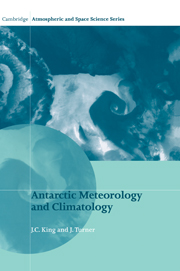Book contents
- Frontmatter
- Contents
- Preface
- Chapter 1 Introduction
- Chapter 2 Observations and instrumentation
- Chapter 3 Physical climatology
- Chapter 4 The large-scale circulation of the Antarctic atmosphere
- Chapter 5 Synoptic-scale weather systems and fronts
- Chapter 6 Mesoscale systems and processes
- Chapter 7 Climate variability and change
- Appendix A A chronological list of stations that have made multiyear meteorological observations in the Antarctic and on the sub-Antarctic islands
- Appendix B A chronological list of automatic weather stations that have been deployed in the Antarctic and on the sub-Antarctic Islands
- References
- Index
Preface
Published online by Cambridge University Press: 02 December 2009
- Frontmatter
- Contents
- Preface
- Chapter 1 Introduction
- Chapter 2 Observations and instrumentation
- Chapter 3 Physical climatology
- Chapter 4 The large-scale circulation of the Antarctic atmosphere
- Chapter 5 Synoptic-scale weather systems and fronts
- Chapter 6 Mesoscale systems and processes
- Chapter 7 Climate variability and change
- Appendix A A chronological list of stations that have made multiyear meteorological observations in the Antarctic and on the sub-Antarctic islands
- Appendix B A chronological list of automatic weather stations that have been deployed in the Antarctic and on the sub-Antarctic Islands
- References
- Index
Summary
Over the last decade there have been great advances in our understanding of the meteorology and climatology of the Antarctic and a consequential increased awareness of the role of the continent in the global climate system. Improved technologies in electronics and communications have facilitated the development of unmanned observing systems, such as automatic weather systems and drifting buoys. These systems have been deployed in previously inaccessible areas, such as the remote interior of the continent and the winter sea ice zone, and have vastly increased the data available for meteorological and climatological studies. In parallel with this development, remote sensing techniques and technologies have been improved and measurements from satellite sensors have contributed greatly to our understanding of the structure and dynamics of Antarctic weather systems. Finally, numerical models have been used increasingly to study the behaviour of the Antarctic atmosphere on scales ranging from the mesoscale to the hemispheric.
In 1984 the late Werner Schwerdtfeger's survey of the meteorology and climatology of the Antarctic regions (Schwerdtfeger, 1984) was published. This important work covered the advances in our understanding of the Antarctic atmosphere that came about as a result of the International Geophysical Year (IGY) of 1957–8 and the First GARP Global Experiment (FGGE) in 1979. Although there have been no co-ordinated efforts comparable in scope to IGY and FGGE over the last decade, the technological advances described above and developments in our theoretical understanding of atmospheric processes have allowed great progress to be made in the study of the major role that the polar regions play in the global climate system, but there is also growing concern about the contribution that the Antarctic ice sheets may make to changes in global sea level.
- Type
- Chapter
- Information
- Antarctic Meteorology and Climatology , pp. ix - xiiPublisher: Cambridge University PressPrint publication year: 1997

